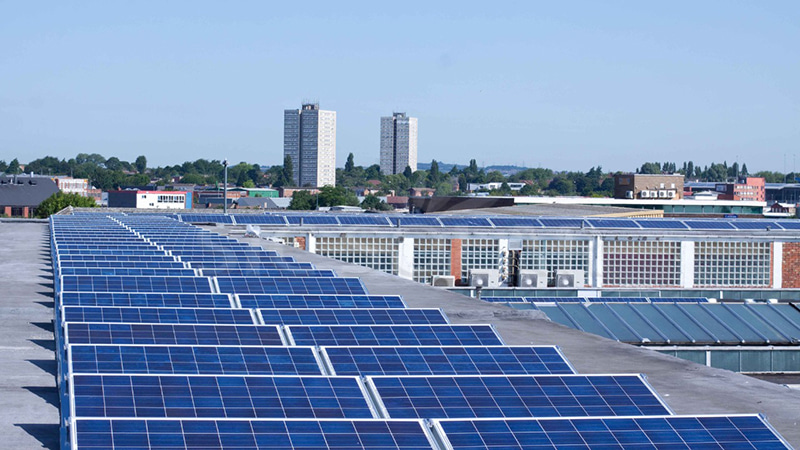When it comes to solar panel installations on flat roofs, one common concern is the tilt angle. Unlike pitched roofs that naturally provide an angle to maximize sunlight exposure, flat roofs do not offer this benefit. The right tilt angle is crucial for optimizing energy production, especially in regions with varying sun angles throughout the year. Fortunately, innovative mounting systems have solved this problem, ensuring that solar panels installed on flat roofs can still achieve maximum efficiency.
1. Why Is the Tilt Angle Important for Solar Panels?
Before diving into how flat roofs handle the tilt angle issue, it’s important to understand why the tilt of solar panels matters so much. Solar panels work best when they are positioned at an optimal angle to capture the most sunlight.
- Maximizing Sun Exposure: The angle at which the solar panels are tilted affects how much sunlight they receive throughout the day, and the tilt needs to match the latitude and seasonal shifts of the sun’s position.
- Improved Performance: Panels installed at the correct angle can capture more sunlight during peak hours, increasing the overall energy output.
- Efficiency: Panels with the correct tilt are less likely to suffer from dust and dirt buildup, which can reduce their effectiveness over time.
For flat roof installations, there’s a challenge: without a natural slope, the panels would need to be elevated or tilted artificially to optimize their angle.
2. How Flat Roof Mounting Systems Solve the Tilt Angle Issue
There are two main ways to solve the tilt angle problem on flat roofs: adjustable mounting racks and ballasted mounting systems. Both systems allow solar panels to be installed at an angle that maximizes solar efficiency.
A. Adjustable Mounting Racks
Adjustable mounting systems are designed to give installers the flexibility to set the optimal tilt angle for each installation. These racks hold the solar panels at a fixed angle, which can be adjusted according to the desired tilt and orientation.
- Flexibility: Installers can choose the ideal tilt based on the geographical location, roof size, and sun exposure.
- Year-Round Efficiency: Adjustable systems can be set at different angles for different seasons, ensuring maximum sun exposure throughout the year.
- Optimized Energy Production: By adjusting the tilt angle, these systems help to capture more sunlight, increasing energy production and improving the overall efficiency of the solar panels.
SIC Solar mounting solutions are designed with flexibility in mind, providing adjustable tilt options that allow you to optimize solar panel orientation for maximum power generation.
B. Ballasted Mounting Systems
Another common solution for flat roof solar installations is the ballasted mounting system. In this setup, solar panels are placed on a base that uses weighted ballast (such as gravel or concrete blocks) to hold the panels in place without the need for roof penetration.
- Angle Adjustment: These ballasted systems typically come with pre-configured tilt angles or allow for some degree of adjustment.
- No Roof Penetration: Since ballasted systems rely on weight to hold the panels in place, they do not require any penetration into the roof, which reduces the risk of leaks and structural damage.
- Cost-Effective: Ballasted systems are often a more cost-effective solution, especially for large-scale commercial installations.
Though ballasted systems are less adjustable than rack-based systems, they still provide an effective solution for tilt angles, especially when combined with SIC Solar durable mounting systems, which ensure that the panels are securely held in place.
3. How SIC Solar Solutions Optimize Tilt for Flat Roofs
SIC Solar offers advanced mounting solutions that cater to both adjustable and ballasted systems for flat roof installations. Here’s how our systems can help optimize the tilt angle and improve energy production:
A. High-Quality, Adjustable Mounting Systems
Our adjustable mounting systems allow you to fine-tune the tilt angle of your solar panels to ensure that they are positioned for optimal sun exposure. Whether you’re installing residential or commercial solar panels, SIC Solar adjustable systems are versatile, reliable, and designed to provide long-term performance.
- Customization: Our systems can be customized to meet your specific needs, taking into account factors like roof size, sun direction, and seasonal changes.
- Durability: SIC Solar mounting solutions are made from high-quality materials that withstand harsh weather conditions, ensuring that your system remains secure and stable.
B. Ballasted Mounting Systems with Flexible Tilt Angles
For those looking for a non-penetrating solution, SIC Solar ballasted systems are an excellent choice. These systems use weight to securely hold the panels in place while allowing for a fixed or adjustable tilt angle. This makes them ideal for large-scale installations on flat roofs where minimizing roof penetration is a priority.
- Reduced Roof Impact: Our ballasted mounting systems avoid the need for drilling into the roof, reducing the risk of damage and maintaining the roof’s integrity.
- Efficient Solar Production: Even with a fixed angle, our ballasted systems are designed to optimize sunlight capture and improve energy output.
C. Easy Installation and Maintenance
Whether you choose adjustable or ballasted systems, SIC Solar mounting solutions are designed for quick installation and easy maintenance. Our solutions come with detailed installation guides and are engineered to integrate seamlessly with a variety of roof types. This makes the installation process faster and more efficient, saving time and costs.
